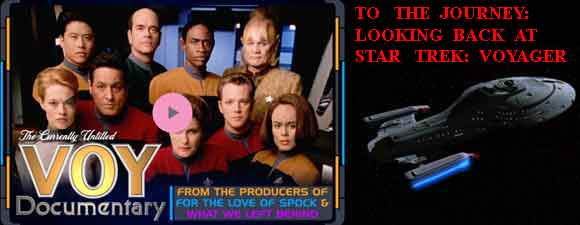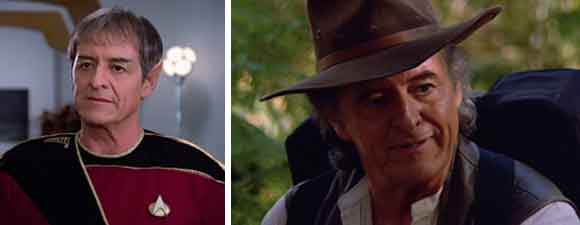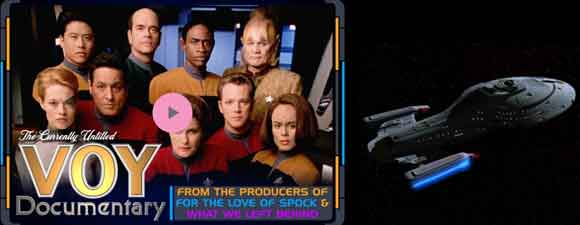Retro Review: Future’s End, Part II
7 min read
futuresend2banner
As Chakotay and Torres are taken captive by anti-government militia, Janeway attempts to stop a businessman threatening the future of the solar system.
Plot Summary: While Janeway and Chakotay ponder how to find Paris and Tuvok and how to retrieve their stolen data from Starling and Chronowerx, Neelix and Kes determine that although most major news organizations consider footage of Voyager to be an elaborate hoax, the military isn’t convinced. Nor is Rain Robinson convinced that Paris and Tuvok are spies from her own era, but she agrees to help them send a message to Voyager from Griffith Observatory and to assist in a plan to abduct Starling in order to prevent him from launching Braxton’s timeship to the 29th century, where it will destroy the solar system. While Janeway gets help in beaming up Starling from the Doctor, who has been given a 29th century autonomous holo-emitter that allows him to move freely in non-holographic environments, Chakotay and Torres take a shuttle to the surface to try to capture the timeship. The shuttle is disguised as a small 20th century aircraft, but it crashes when Chakotay attempts to beam Starling aboard without knowing Starling can disrupt their pattern buffers. Voyager takes over the transport and beams Starling to the ship, where he explains that improving technology and getting rich in his own era is more important than a disaster centuries in Earth’s future. One of Starling’s lackeys rescues him from Voyager right through the ship’s shields and beams him to the surface. While Tuvok and the EMH rescue Chakotay and Torres from anti-government militia members, who found them after the crash and believe them to be federal spies, Robinson takes Paris to try to retrieve the timeship, which Starling flies through the roof of the Chronowerx building. With Voyager’s weapons down, Janeway fires a torpedo manually to blast apart the timeship as it accelerates toward the temporal rift. The rift closes, then opens to reveal Captain Braxton, who has no memories of the 29th century disaster. He announces that he has come to return Voyager to its proper time, yet because of the Temporal Prime Directive, he can’t allow the crew to remain at Earth. Even so, once back in the Delta Quadrant, Janeway toasts their success and the EMH’s new emitter.
Analysis: As is often the case with sequels, Part II of “Future’s End” doesn’t quite reach the heights of Part I, but it’s still a very enjoyable episode which makes great use of the regular and guest cast as well as its setting. There are a few too many red herrings and a lot of distraction, not only for the crew but for the audience, plus some of the science seems pretty ridiculous, as if saying “It’s from the 29th century!” gives one permission to use the equivalent of magic. I’ve never been sure of the point of the anti-government militia, characterized as a bunch of bigoted rednecks rather than something more equivalent to the Maquis. Are we supposed to take these well-armed throwbacks as a cautionary tale, the inevitable result of Starling’s tampering with the timeline and triggering the computer revolution before the human race is ready? Or are we supposed to feel smug about the military might of Starfleet and its technology as the newly-mobile EMH walks through a rain of bullets to rescue the “Indian” and the Klingon (like a Vulcan, probably not the best choice to risk putting on 20th century Earth)? It’s a great idea to give the Doc permanent mobility, and I don’t object to the magical 29th century tech being the source of that advancement, but it makes the relatively new-to-the-franchise Temporal Prime Directive seem inconsistent, since Janeway could presumably reverse-engineer this emitter as easily as Starling strips technology from the futuristic timeship, changing the sequence of events leading to the future that Braxton tries to preserve by sending Voyager back to the Delta Quadrant and a longer trip home. We’ve seen similar incidents before, like when Scotty gives the formula for transparent aluminum to a 20th century engineer because Kirk’s crew needs equipment to bring extinct whales to their own century, but considering that the gimmick of “Future’s End” is all about the dangers of letting people get their hands on tech from centuries in their future, it’s odd that the mobile emitter is overlooked even as we see an exploration of the paranoia of those who don’t trust tech in the hands of centralized authority.
Really, I can’t understand why Janeway doesn’t tell Braxton to go away so she can take her chances on a slingshot around the sun, a time travel mechanism already widely known in Captain Kirk’s era. Star Trek is often quick to judge scientists using technology that they didn’t create or can’t control – Daystrom and the M-5, Soong and his android prototypes, David Marcus and the Genesis torpedo – yet Starling doesn’t fit neatly into the equation, in part because everyone watching the episode is presumably a benefactor of the breakthrough he stole from the future, namely the boom in computers at the end of the last century, which Janeway and Chakotay agree should never have happened. Strange that Braxton’s initial plan is to go back and blow up Voyager because of debris found in the 29th century disaster, rather than figuring out that Starling had altered the timeline centuries earlier; maybe the microcomputer revolution is so important that the rather comical Department of Temporal Investigations is forced to let it happen despite the manipulation of time that triggered it? We’re meant to judge Starling for his greed, transforming from a hippie into a billionaire with fancy toys in his office, but I’d rather spend an afternoon debating ethics with him than with Chakotay’s gun-toting isolationist kidnappers Butch and Porter. So far as we learn, Starling isn’t planning to run for president or use his weapons to overthrow world leaders. He may be greedy, but, as he points out, his products benefit thousands of other people – everyone who uses the internet – and we get no indication that they come with any draconian ideological demands attached, only a willingness to exploit the same business loopholes and deregulation open to other companies of his era. Let’s be honest: I’d be distraught if asked to give up my laptop and mobile phone even if you could prove to me that, 900 years from now, they would make the solar system explode. It’s the economy-versus-environment debate of our own era, when we know we must drastically reduce our emissions or we’ll destroy the planet, yet we want to be able to eat McDonald’s cheeseburgers, fly to Florida in the winter, and buy cheap clothes made under terrible conditions out of materials that should never have been synthesized.
I love the scene with Chakotay and Torres in the shuttle discussing what they’d do if Voyager got stuck in the 20th century, something I’ve always thought would make a great premise for a Star Trek series: a crew trapped in the past, caught between the Prime Directive, protecting the future, and their desire to help people achieve their potential while avoiding known impending disasters. Chakotay wishes he could become a famous archaeologist, except of course he wouldn’t be allowed to discover anything at all. Paris might hit it off with 20th century women who share his taste in horror movies, but he couldn’t risk impregnating any woman or stopping her from producing potentially important offspring with someone else. And what about Janeway, who ignored the Prime Directive to save the Ocampa – could she let earthquakes and AIDS and the Bell Riots and the limited nuclear war of Star Trek’s 21st century wreak havoc without warning anyone? She has a fairly strong outing in “Future’s End, Part II” despite being stuck on the ship, though I’m not sure why she felt she had to fire the torpedo manually herself when there are surely engineers on board both better qualified and more expendable. I like that she never orders a crewmember to do things she wouldn’t do herself, but if Tuvok or Chakotay had been around, they’d have called it illogical and much too risky. I’m glad the whole crew gets to remember this alternate timeline and that it has lasting consequences, notably the Doctor’s freedom from Sickbay, although I wish the crew made reference once in a while to the experience of traveling back in time to save the future and what they learned on old Earth. One of my favorite bits is watching Neelix and Kes watch soap operas, the genre that gave several actors on this show their big breaks, particularly Kate Mulgrew. Voyager‘s writers could have learned from Kes’s comments about what makes ongoing narrative structure and intimate character revelations so satisfying to viewers.






